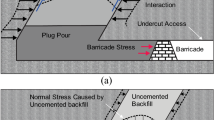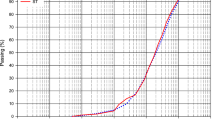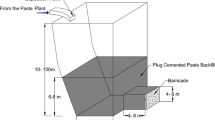Abstract
The mechanical performance of cemented paste backfill (CPB) placed in deep stopes often differs from laboratory-predicted performance, and the strength of CPB is generally determined to the uniaxial compressive strength (UCS) after the predetermined curing ages in laboratory. However, in situ backfilled stopes, the CPB is enclosed by the orebody and surrounding rocks usually, and the mechanical performance of CPB should not only be determined by the UCS. To investigate the mechanical performance of CPB in deep stopes during long-term service, the physical and mechanical conditions of CPB in situ backfilled stopes were simulated by the confined high-stress consolidation (CHSC), and the microstructure of CPB made by scanning electron microscopy was analyzed, and the strength regeneration mechanism of CPB was investigated from the microscopic point of view. The results showed that the strength of CPB in deep stopes could be excited to various degrees during long-term service, and the degree of excitation was closely related to the curing ages of CPB. The degree of excitation of the CPB strength was determined by the maximum confined consolidation stress, and the consolidated CPB was more beneficial to its supporting role in engineering. The macroscopic strength of CPB after CHSC can be increased by the increase of bond strength at the interfacial transition zone and the improvement of overall compactness of CPB. The re-filling and re-cementation of micro-cracks result in the strengthening of CPB during the re-curing ages. Compression consolidation (primary consolidation) and chemical consolidation (sub-consolidation) of CPB in the backfilled stopes occur simultaneously, and this is obviously different from the process of the compression consolidation of soil.















Similar content being viewed by others
References
Ahmad MS, Shah SS (2016) Load settlement behaviour of fly ash mixed with waste sludge and cement. Geotech Geol Eng 34(1):37–58
Belem T, Benzaazoua M (2008) Design and application of underground mine paste backfill technology. Geotech Geol Eng 26(2):147–174
Belem T, Fourie AB, Fahey M (2010) Time-dependent failure criterion for cemented paste backfills. In: Proceedings of the 13th international seminar on paste and thickened tailings. Australian Centre for Geomechanics, pp 147–162
Belem T, El Aatar O, Bussière B, Benzaazoua M (2016) Gravity-driven 1-D consolidation of cemented paste backfill in 3-m-high columns. Innov Infrastruct Solut 1(1):37
Bentz DP (2009) Influence of internal curing using lightweight aggregates on interfacial transition zone percolation and chloride ingress in mortars. Cem Concr Compos 31(5):285–289
Cui L, Fall M (2016a) Mechanical and thermal properties of cemented tailings materials at early ages: influence of initial temperature, curing stress and drainage conditions. Constr Build Mater 125:553–563
Cui L, Fall M (2016b) Multiphysics model for consolidation behavior of cemented paste backfill. Int J Geomech 17(3):04016077
Demie S, Nuruddin MF, Shafiq N (2013) Effects of micro-structure characteristics of interfacial transition zone on the compressive strength of self-compacting geopolymer concrete. Constr Build Mater 41:91–98
du Plessis GE, Liebenberg L, Mathews EH (2013) Case study: the effects of a variable flow energy saving strategy on a deep-mine cooling system. Appl Energy 102:700–709
Duan P, Shui Z, Chen W, Shen C (2013) Effects of metakaolin, silica fume and slag on pore structure, interfacial transition zone and compressive strength of concrete. Constr Build Mater 44:1–6
Fall M, Pokharel M (2010) Coupled effects of sulphate and temperature on the strength development of cemented tailings backfills: Portland cement-paste backfill. Cem Concr Compos 32(10):819–828
Fall M, Célestin JC, Pokharel M, Touré M (2010) A contribution to understanding the effects of curing temperature on the mechanical properties of mine cemented tailings backfill. Eng Geol 114(3–4):397–413
Ghirian A, Fall M (2014) Coupled thermo-hydro-mechanical-chemical behaviour of cemented paste backfill in column experiments: part II: mechanical, chemical and microstructural processes and characteristics. Eng Geol 170:11–23
Ghirian A, Fall M (2015) Coupled behavior of cemented paste backfill at early ages. Geotech Geol Eng 33(5):1141–1166
Ghirian A, Fall M (2016) Strength evolution and deformation behaviour of cemented paste backfill at early ages: effect of curing stress, filling strategy and drainage. Int J Min Sci Technol 26(5):809–817
Gorakhki MH, Bareither CA (2018) Compression behavior of mine tailings amended with cementitious binders. Geotech Geol Eng 36(1):27–47
Huang S, Xia K, Qiao L (2011) Dynamic tests of cemented paste backfill: effects of strain rate, curing time, and cement content on compressive strength. J Mater Sci 46(15):5165–5170
Koohestani B, Koubaa A, Belem T, Bussière B, Bouzahzahet H (2016) Experimental investigation of mechanical and microstructural properties of cemented paste backfill containing maple-wood filler. Constr Build Mater 121:222–228
Kwiatek G, Plenkers K, Dresen G (2011) Source parameters of picoseismicity recorded at Mponeng deep gold mine, South Africa: implications for scaling relations. Bull Seismol Soc Am 101(6):2592–2608
Li JJ, Hu MS, Ding E, Kong W, Pan DM, Chen S (2016) Multi-parameter numerical simulation of dynamic monitoring of rock deformation in deep mining. Int J Min Sci Technol 26(5):851–855
Lin F, Meyer C (2009) Hydration kinetics modeling of Portland cement considering the effects of curing temperature and applied pressure. Cem Concr Res 39(4):255–265
Liu RG, Han FH, Yan PY (2013) Characteristics of two types of CSH gel in hardened complex binder pastes blended with slag. Sci China Technol Sci 56(6):1395–1402
Liu L, Fang Z, Qi C, Zhang B, Guo L, Song KI (2018) Experimental investigation on the relationship between pore characteristics and unconfined compressive strength of cemented paste backfill. Constr Build Mater 179:254–264
Niroshan N, Yin L, Sivakugan N, Veenstra RL (2018) Relevance of SEM to long-term mechanical properties of cemented paste backfill. Geotech Geol Eng 36:2171–2187
Rong H, Zhou M, Hou H (2017) Pore structure evolution and its effect on strength development of sulfate-containing cemented paste backfill. Minerals 7(1):8
Sheshpari M (2015) A review of underground mine backfilling methods with emphasis on cemented paste backfill. Electron J Geotech Eng 20(13):5183–5208
Sun W, Wu A, Hou K, Yang Y, Liu L, Wen Y (2016) Real-time observation of meso-fracture process in backfill body during mine subsidence using X-ray CT under uniaxial compressive conditions. Constr Build Mater 113:153–162
Tan Q, Tang H, Fan L, Xiong C, Fan Z, Zhao M et al (2018) In situ triaxial creep test for investigating deformational properties of gravelly sliding zone soil: example of the Huangtupo 1# landslide, China. Landslide 15(12):2499–2508
Wang ZK, Yang P (2016) Damage constitutive model after confined compression consolidation of tailings-cemented backfill. Electron J Geotech Eng 41(21):5305–5317
Wang ZK, Yang P, Lyu WS (2018) Study of the backfill confined consolidation law and creep constitutive model under high stress. Geotech Test J 41(2):390–402
Wu D, Zhao R, Qu C (2019) Effect of curing temperature on mechanical performance and acoustic emission properties of cemented coal gangue-fly ash backfill. Geotech Geol Eng 37:3241–3253
Yan B, Tannant D, Lv W, Cai M (2018) Effect of fly ash on the mechanical properties of cemented backfill made with brine. Geotech Geol Eng 37:691–705
Yang CC, Su JK (2002) Approximate migration coefficient of interfacial transition zone and the effect of aggregate content on the migration coefficient of mortar. Cem Concr Res 32(10):1559–1565
Yilmaz E, Benzaazoua M, Belem T (2009) Effect of curing under pressure on compressive strength development of cemented paste backfill. Miner Eng 22(9):772–785
Yilmaz E, Belem T, Benzaazoua M, Kesimal A, Ercikdi B, Cihangir F (2011a) Use of high-density paste backfill for safe disposal of copper/zinc mine tailings. Gospod Surowcami Miner 27:81–94
Yilmaz E, Belem T, Bussière B (2011b) Relationships between microstructural properties and compressive strength of consolidated and unconsolidated cemented paste backfills. Cem Concr Compos 33(6):702–715
Yilmaz E, Belem T, Benzaazoua M (2012) One-dimensional consolidation parameters of cemented paste backfills. Gospod Surowcami Miner 28(4):29–45
Yilmaz E, Belem T, Benzaazoua M (2013) Effects of curing and stress conditions on hydromechanical, geotechnical and geochemical properties of cemented paste backfill. Eng Geol 168:23–37
Yu GB, Yang P, Chen YZ (2013) Study on damage constitutive model of cemented tailings backfill under uniaxial compression. Appl Mech Mater 353:379–383
Zhang Y, Liu C, Liu Z, Liu G, Yang L (2017) Modelling of diffusion behavior of ions in low-density and high-density calcium silicate hydrate. Constr Build Mater 155:965–980
Acknowledgements
This work was supported by the National Science & Technology Pillar Program during the 12th “Five Year” Plan period in China (2011BAZ03382).
Author information
Authors and Affiliations
Corresponding author
Additional information
Publisher's Note
Springer Nature remains neutral with regard to jurisdictional claims in published maps and institutional affiliations.
Rights and permissions
About this article
Cite this article
Yang, C., Yang, P., Lv, Ws. et al. Mechanical Performance of Confined Consolidation on the Strength Development of Cemented Paste Backfill. Geotech Geol Eng 38, 1097–1110 (2020). https://doi.org/10.1007/s10706-019-01074-x
Received:
Accepted:
Published:
Issue Date:
DOI: https://doi.org/10.1007/s10706-019-01074-x




